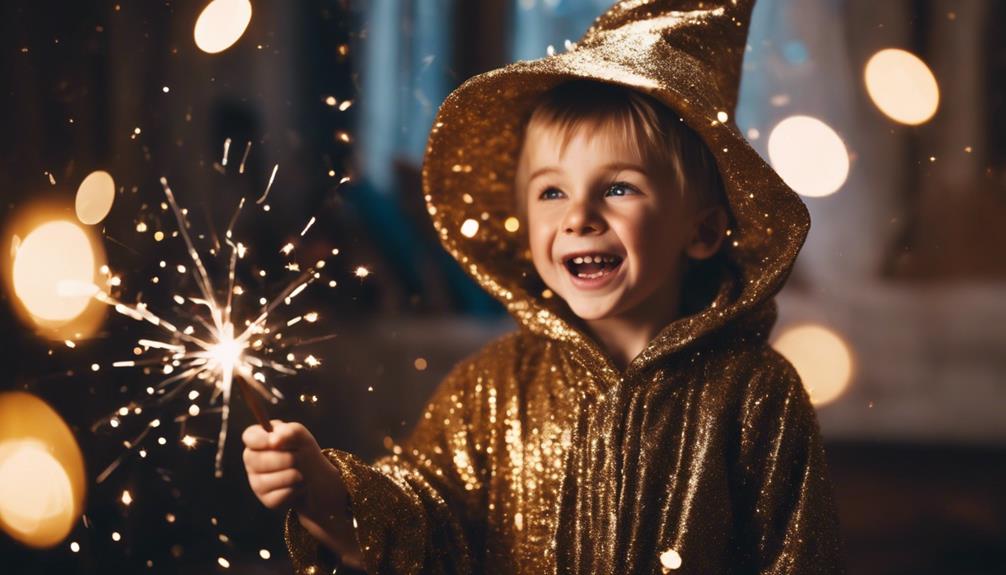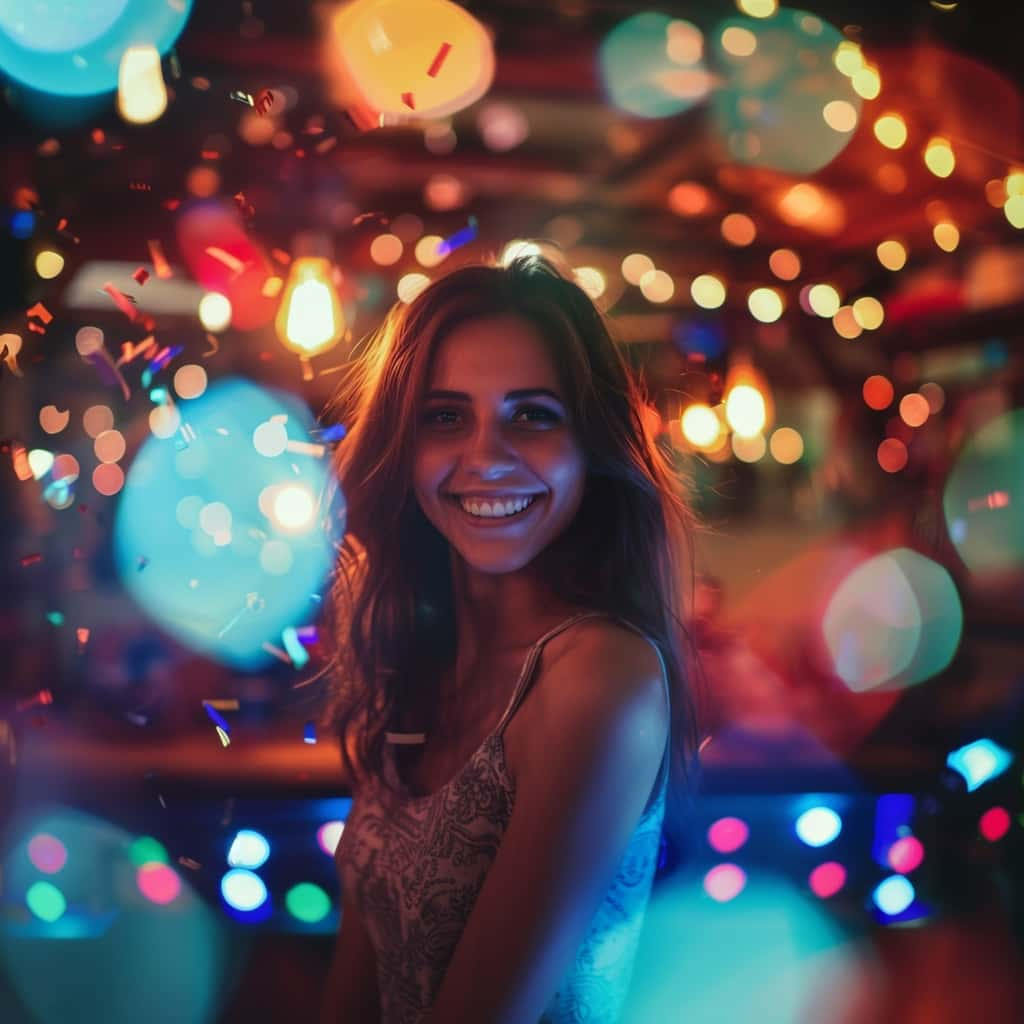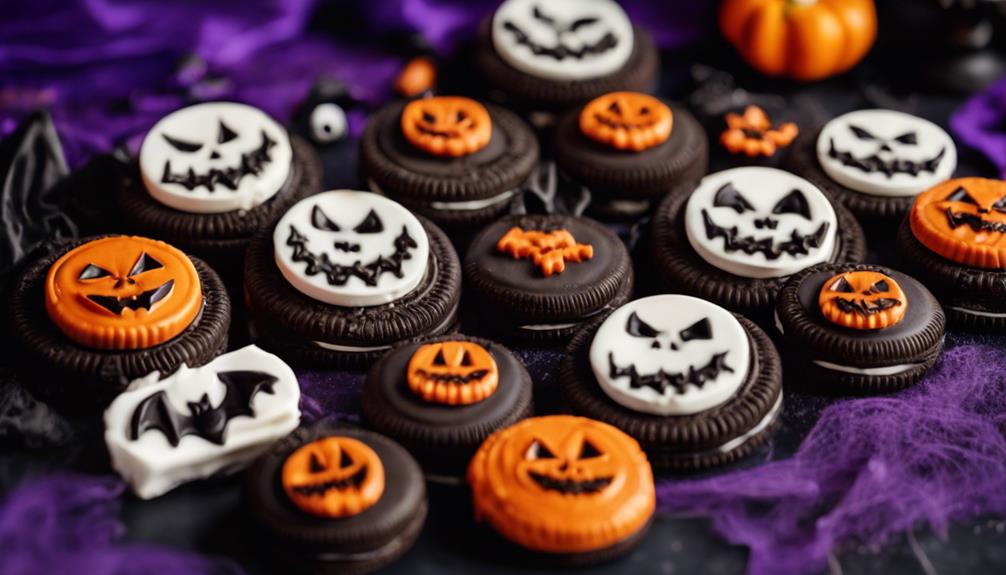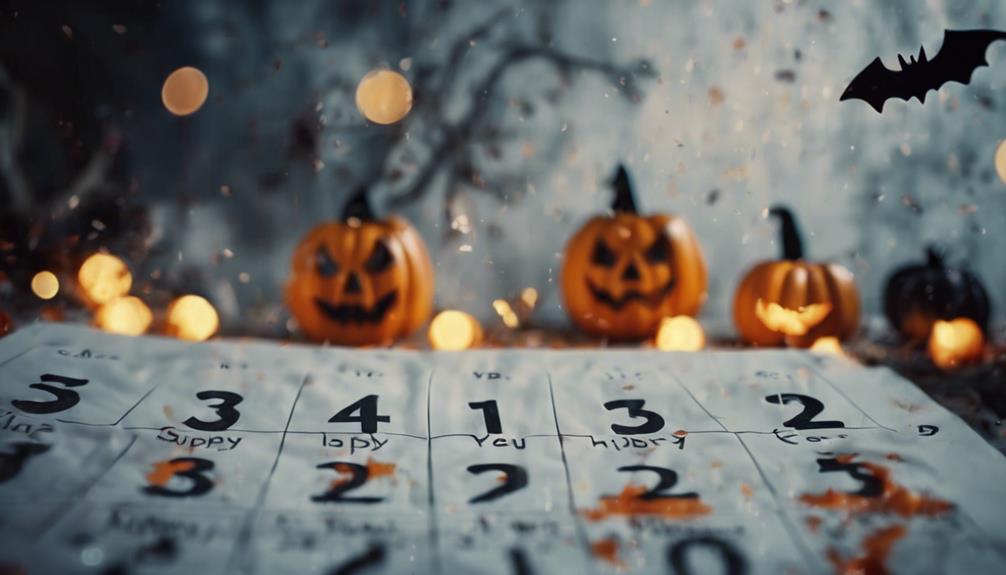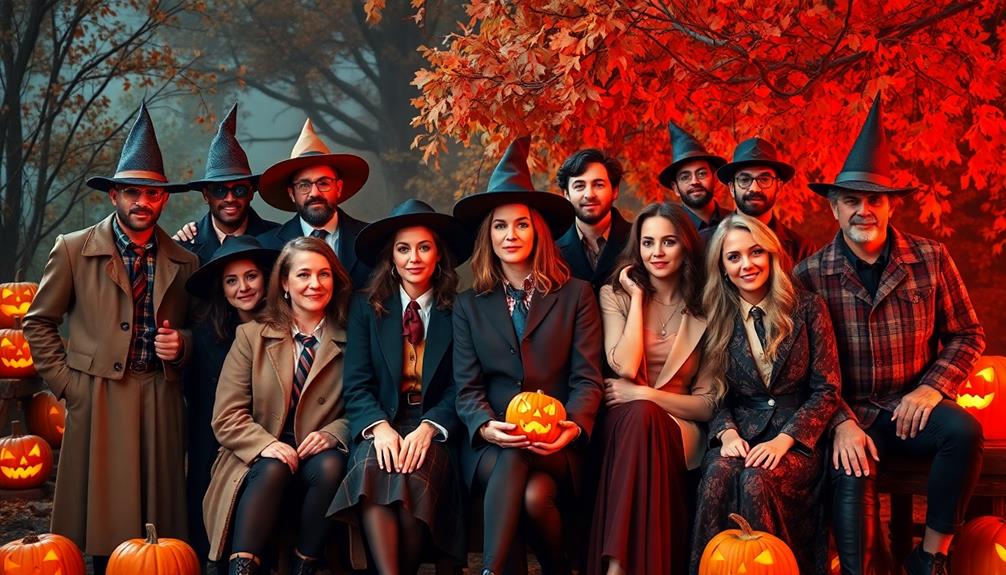Halloween greatly impacts American culture. Originating from English Puritans, it evolved into a blend of English, Irish, and Native American customs. Commercially, Halloween is a multi-billion dollar industry, driving consumer spending on costumes, decorations, and candy. Family traditions like pumpkin carving and trick-or-treating strengthen bonds and promote creativity. Pop culture is heavily influenced by Halloween symbols, with movies and music embracing spooky themes. Psychological effects include facing fears in a fun way. The holiday's future trends focus on inclusivity, sustainability, and technology. Discover more about Halloween's multifaceted impact on American society.
Key Takeaways
- Halloween blends diverse cultural traditions, shaping American celebrations.
- Commercialization boosts the economy with billions spent annually.
- Family traditions strengthen through activities like pumpkin carving.
- Pop culture influences and reflects Halloween themes in movies, music, and more.
- Halloween provides cathartic experiences, promotes creativity, and stimulates community engagement.
Origins of Halloween in America
The origins of Halloween in America can be traced back to English Puritan colonists who introduced the holiday as a time for play parties. In the early American Colonies, Halloween was celebrated as All Hallows Eve, a day filled with costumes, fortune-telling, and scary stories. These traditions laid the foundation for the modern Halloween celebrations we're familiar with today. Initially a religious observance, Halloween in America gradually shifted towards a secular celebration focused on spooky themes and entertainment.
The American Colonies played a vital role in shaping Halloween into the festive occasion it's now. The blending of English, Irish, and Native American customs during this period contributed to the unique Halloween traditions observed in the United States. As Halloween evolved over time, it became less about religious significance and more about community gatherings, fun activities, and creative expression. This transformation set the stage for the commercialization of Halloween in America, marking the beginning of its widespread popularity and cultural impact.
Commercialization of Halloween

With the economic boom of Halloween in America, the holiday's commercialization has skyrocketed, influencing consumer behavior and transforming the cultural landscape.
Halloween has evolved into a massive economic industry in the United States, with billions of dollars spent on costumes, decorations, and candy each year. The commercialization of Halloween has paved the way for the year-round presence of Halloween stores, catering to the increasing demand for themed merchandise.
Consumer spending experiences a significant surge during October, driven by the purchase of Halloween-related items. Despite varying religious beliefs, a majority of American families actively partake in Halloween celebrations, contributing to the holiday's commercial success.
The emphasis on horror, entertainment, and consumerism has reshaped the modern interpretation of Halloween in America. This commercialization hasn't only made Halloween a widely celebrated cultural phenomenon but has also turned it into a highly profitable industry with a global impact.
Impact on Family Traditions

Halloween has a significant impact on family traditions by fostering activities like pumpkin carving and costume-making that bring families together. These traditions, such as visiting haunted houses and throwing themed parties, help create lasting memories and strengthen familial bonds.
Through shared experiences and creative endeavors, Halloween reinforces cultural values and generational rituals within families.
Family Bonding Activities
Engaging in various family bonding activities during the Halloween season enhances familial connections and creates cherished memories. These activities not only bring families closer but also provide opportunities for creativity and teamwork. Here are five ways in which family bonding activities impact Halloween traditions:
- Pumpkin Carving and Decorating: Working together to carve pumpkins and decorate them with unique designs strengthens family relationships and adds a festive touch to the home.
- Costume Creation and Planning: Collaborating on costume ideas and putting together outfits fosters creativity and unity among family members.
- Trick-or-Treating Together: Going trick-or-treating as a family tradition promotes togetherness and shared experiences, making Halloween celebrations more meaningful.
- Hosting Halloween Parties: Organizing Halloween parties and gatherings at home encourages social interaction and community involvement, creating lasting memories for all family members.
- Spooky Movie Nights: Enjoying spooky movies or storytelling sessions as a family cultivates a sense of togetherness and fun during the Halloween season.
Generational Rituals Sharing
As families engage in generational rituals during Halloween, they actively share and pass down traditions that contribute to the richness of their family customs and values. Halloween serves as a significant time for family bonding, where shared traditions like pumpkin carving and trick-or-treating bring family members together.
Creating costumes and decorations becomes a collective activity that strengthens relationships through shared experiences. The exchange of stories and memories related to past Halloweens enhances family connections and creates lasting traditions that are passed down through generations.
Activities such as haunted house visits, movie nights, and festive gatherings during Halloween further promote family togetherness and unity. Through these shared traditions, families reinforce their bonds, instill values, and create a sense of belonging that transcends generations.
Halloween rituals not only provide fun and entertainment but also play a vital role in preserving family customs and strengthening the ties that bind generations together.
Cultural Values Reinforcement
Strengthening family bonds and reinforcing cultural values, the traditions observed during Halloween serve as an essential means of fostering togetherness and passing down heritage through shared experiences. Halloween, rooted in the ancient Celtic festival of Samhain, has evolved into a modern celebration that blends fun activities with religious traditions.
Here are five ways Halloween impacts family traditions:
- Encourages activities like pumpkin carving and trick-or-treating.
- Fosters bonding through shared experiences of dressing up in costumes.
- Promotes creativity and imagination in planning costumes and decorations.
- Provides opportunities for intergenerational connections through passing down traditions.
- Instills a sense of community as neighborhoods come together for festive events.
Influence on Pop Culture

Halloween has left a lasting mark on American pop culture through its presence in movies and music. Iconic symbols like Jack-o'-lanterns and witches continue to influence various aspects of entertainment, from films to Halloween-themed music.
Costumes inspired by popular culture, such as superheroes and movie characters, have become staples in the celebration of Halloween in the United States.
Halloween in Movies
Horror movies centered around Halloween play a pivotal role in shaping American pop culture and influencing how the holiday is celebrated. These Halloween movies have made a lasting impact on American culture by:
- Setting the tone for modern Halloween traditions and themes.
- Featuring iconic villains and settings synonymous with the spooky atmosphere of Halloween.
- Contributing to a thriving industry of horror films and Halloween-themed entertainment.
- Creating excitement and anticipation surrounding the holiday.
- Shaping how Halloween is perceived and celebrated in American culture.
From classics like 'Halloween' (1978) to modern horror hits, Halloween movies have become a significant part of pop culture, influencing the way people celebrate this spooky holiday. The success of these films hasn't only entertained audiences but also contributed to the overall Halloween experience, making them an integral part of the holiday's celebration in American society.
Costumes in Music
Influencing pop culture with their innovative and theatrical costumes, musicians like David Bowie, Lady Gaga, and Madonna have left a lasting impact on the music industry. Costumes in music play a significant role in creating visual spectacles that captivate audiences during performances and music videos. Artists often use elaborate costumes to enhance storytelling and create memorable experiences for fans. Halloween-themed music videos, such as Michael Jackson's 'Thriller,' have become iconic for their use of costumes and special effects, showcasing the influence of Halloween on music culture.
The fashion choices of musicians during Halloween events and concerts not only reflect their creativity but also set trends and inspire fans to embrace costumes and dress up in imaginative ways. Costumes in music have become a powerful tool for artists to express themselves, push boundaries, and leave a lasting impression on pop culture. By incorporating costumes into their artistry, musicians continue to shape the music industry and influence how fans engage with their favorite songs and performances.
Evolution of Halloween Costumes

Over the years, the transformation of Halloween costumes has reflected the shifting cultural interests and influences of society. Here are some key points to take into account:
- Halloween costumes have evolved from traditional monsters and ghosts to include modern characters like superheroes and celebrities.
- Costumes are a significant part of Halloween celebrations, allowing people to express creativity and imagination.
- The popularity of Halloween costume parties and events has contributed to the evolution of costume trends.
- People of all ages participate in dressing up for Halloween, with costume sales being a major industry during the holiday season.
- Social media platforms showcase elaborate and creative Halloween costumes, influencing trends and inspiring others to join in the fun.
The evolution of Halloween costumes not only showcases the changing interests of society but also provides a platform for individuals to showcase their creativity and immerse themselves in the festive spirit of Halloween.
Halloween's Economic Impact

The evolution of Halloween costumes not only reflects societal interests but also has a significant impact on the American economy through the sale of costumes, decorations, candy, and party supplies. Halloween generates billions of dollars in revenue for the economy, with businesses like seasonal stores, online retailers, and local shops experiencing a substantial boost in sales during the Halloween season. Communities and businesses nationwide organize Halloween events, haunted houses, and themed activities to attract customers, stimulating local economies.
This economic influence extends to various sectors, including retail, entertainment, hospitality, and tourism, creating job opportunities and increasing consumer spending. The demand for seasonal products, such as costumes and decorations, rises during this time, leading to advertising campaigns and promotional events tailored to the holiday market. The Halloween industry plays an essential role in driving retail sales and boosting the economy through the sale of Halloween-themed products and services.
Halloween in Media and Entertainment

Halloween in media and entertainment plays a significant role in shaping the holiday's cultural impact. From classic horror films to special holiday-themed TV episodes, the portrayal of Halloween in various forms of media influences how people perceive and celebrate the occasion.
The entertainment industry's embrace of Halloween themes contributes to the festive spirit and excitement surrounding the holiday each year.
Media Portrayal of Halloween
Media and entertainment industries heavily feature Halloween as a prominent theme, influencing a wide range of content from movies to TV shows to video games. Here are some key points to take into account:
- Iconic Films: Halloween is a popular theme in movies, with classics like 'Halloween' (1978) shaping the horror genre.
- TV Specials: TV specials such as 'It's the Great Pumpkin, Charlie Brown' have become a staple for families during the Halloween season.
- Sitcoms and Dramas: Halloween episodes in sitcoms and dramas often showcase costume parties, spooky decorations, and supernatural elements.
- Streaming Platforms: Streaming services release Halloween-themed content, offering a variety of horror movies, TV series, and documentaries related to the holiday.
- Video Games: Gaming industry incorporates Halloween into its content with themed events, updates, costumes, challenges, and spooky settings for players to enjoy.
The portrayal of Halloween in media and entertainment continues to captivate audiences across various platforms, providing a mix of spooky, fun, and thrilling experiences.
Entertainment Industry Influence
Within entertainment circles, the influence of Halloween manifests through a myriad of engaging and revenue-generating avenues. Halloween-themed movies and TV shows rake in billions of dollars for the entertainment industry annually, captivating audiences with spooky narratives and thrilling experiences. The horror genre sees a significant spike in popularity during the Halloween season, drawing in larger viewership and achieving box office success.
Additionally, Halloween-inspired video games and virtual events offer interactive entertainment, immersing participants in chilling and festive experiences. Celebrities and influencers often partake in Halloween-themed content, boosting engagement and attracting a diverse audience keen for seasonal entertainment. Streaming platforms cater to this demand by curating special Halloween playlists and programming, ensuring that audiences have access to a wide range of spooky and thrilling content to enjoy during the festive season.
The entertainment industry's embrace of Halloween not only entertains but also contributes substantially to the cultural significance and economic impact of this holiday.
Social Aspects of Halloween Celebrations

Social connections and community spirit are at the heart of the social aspects of American Halloween celebrations, fostering a sense of camaraderie and togetherness among participants. Here are some key points to ponder:
- Costumes: Halloween encourages creativity and self-expression through a wide variety of costumes, allowing individuals to showcase their unique personalities.
- Trick-or-Treating: The tradition of trick-or-treating promotes neighborly connections and strengthens community bonds as children go door-to-door collecting treats.
- Decorations: Elaborate Halloween decorations not only create a festive atmosphere but also bring people together to admire the creativity and effort put into them.
- Charitable Giving: Halloween events provide opportunities for charitable giving and fundraising, supporting important causes like UNICEF and local community initiatives.
- Cultural Diversity: American Halloween celebrations showcase the cultural diversity and creativity of communities through the diverse costume choices and themed events.
Psychological Effects of Halloween

Exploring the psychological effects of Halloween reveals how this holiday offers individuals a unique opportunity to confront fears and experience an exhilarating release of emotions in a controlled setting. Halloween, stemming from the ancient Celtic festival of Samhain, allows people to engage with their fears through spooky decorations, haunted houses, and scary stories.
By immersing yourself in these frightening experiences, you can confront anxieties in a safe environment, leading to a cathartic release of pent-up emotions. The thrill and excitement of Halloween activities trigger the release of adrenaline and endorphins, boosting your mood and creating a sense of exhilaration.
Dressing up in costumes not only promotes self-expression and creativity but also enables you to temporarily embody different personas, fostering a sense of exploration and identity play. The element of surprise and unpredictability in Halloween traditions stimulates your brain, promoting feelings of excitement and engagement.
Additionally, participating in Halloween festivities with loved ones can strengthen social connections, enhancing your overall well-being and sense of belonging.
Future Trends in Halloween Celebrations
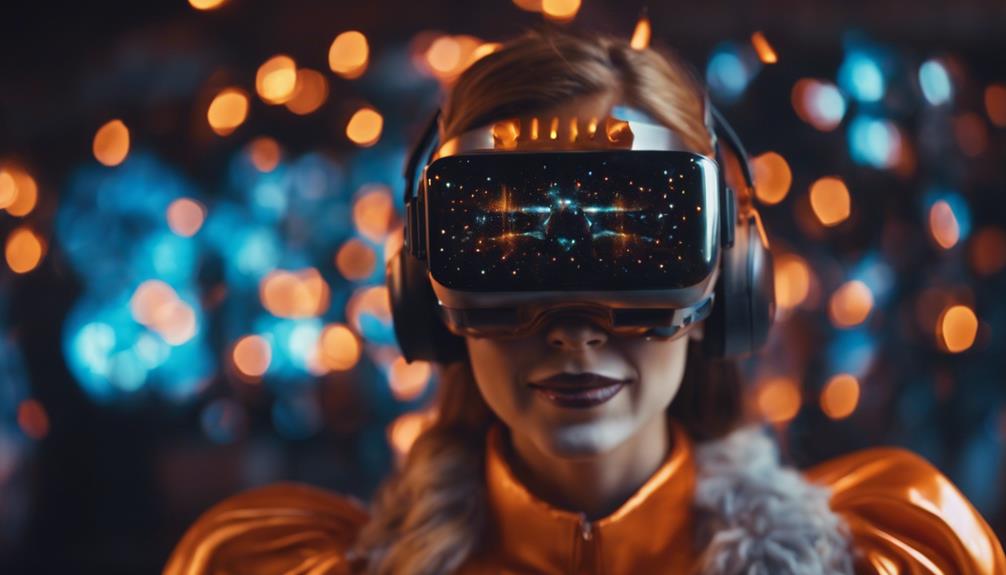
Looking ahead to the future of Halloween celebrations, you can expect to see a rise in virtual reality experiences and augmented reality games as popular additions to the traditional festivities. As Halloween evolves, here are some trends you might encounter:
- Virtual reality experiences offering immersive and interactive Halloween adventures.
- Inclusive costumes representing a diverse range of cultures and identities.
- Sustainable and eco-friendly decorations and costumes gaining popularity.
- Collaborations between tech companies and event organizers for interactive experiences.
- Increased focus on mental health awareness with activities promoting well-being.
These trends indicate a shift towards more interactive, inclusive, and environmentally conscious Halloween celebrations.
Embracing technology, diversity, sustainability, and well-being are set to shape the future of Halloween, offering new experiences and opportunities for individuals to engage with the holiday in meaningful ways.
Frequently Asked Questions
How Is Halloween Part of American Culture?
Halloween is deeply ingrained in American culture, with traditions like trick-or-treating, costume parties, and haunted houses being integral. Schools, communities, and businesses across the U.S. embrace Halloween with events and decorations, showcasing its widespread significance in society.
With over 172 million Americans participating annually and spending an average of $86 per person on Halloween-related items, the holiday's impact on consumer behavior and the economy is evident.
What Is the Cultural Significance of Halloween?
Halloween holds cultural significance as a celebration rooted in Celtic and European traditions, symbolizing the thin boundary between natural and supernatural worlds. This festive occasion involves dressing up, parties, pumpkin carving, and trick-or-treating.
In American culture, it's a blend of historical customs, modern entertainment, and community engagement. The commercial aspect has made it a significant economic event with billions spent on costumes and decorations.
Halloween shapes the cultural fabric of the United States with its fun and spooky elements.
Why Is Halloween Such a Big Deal in America?
Halloween is a big deal in America because it offers a fun way for people to express their creativity and engage in spooky festivities. The holiday's roots in Celtic and European traditions have evolved into a cultural phenomenon that encourages self-expression and community bonding.
Americans embrace Halloween with enthusiasm, participating in activities like trick-or-treating, themed parties, and haunted houses. The commercialization of Halloween has also played a significant role in making it a widely celebrated event in the US.
How Did Halloween Change When It Came to America?
When Halloween came to America, it shifted from religious to secular celebrations, thanks to play parties gaining popularity. American colonists brought over English customs, transforming All Hallows Eve into a festive holiday. Costumes, fortune-telling, and spooky stories revamped Halloween traditions.
Conclusion
To wrap up, Halloween has had a significant impact on American culture through its origins, commercialization, influence on traditions, and presence in pop culture.
The evolution of costumes, media representation, and social aspects of celebrations all contribute to the psychological effects experienced by individuals.
As Halloween continues to evolve, future trends in celebrations will shape how this holiday is perceived and celebrated in the years to come.

